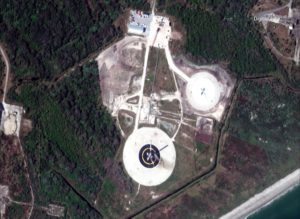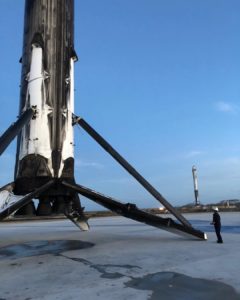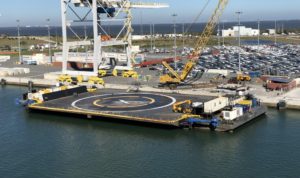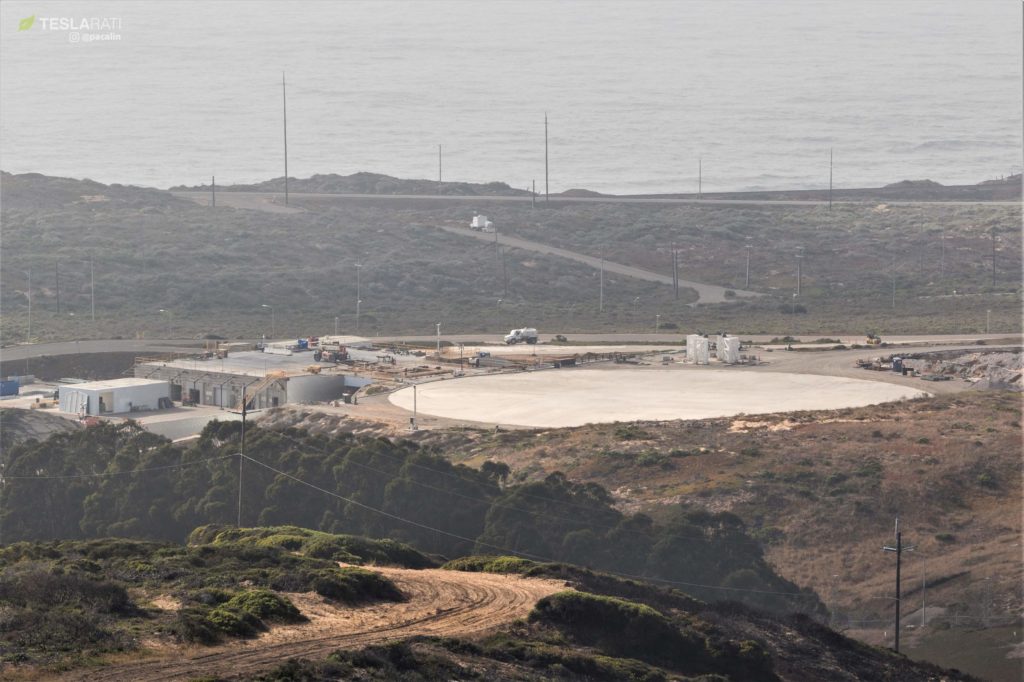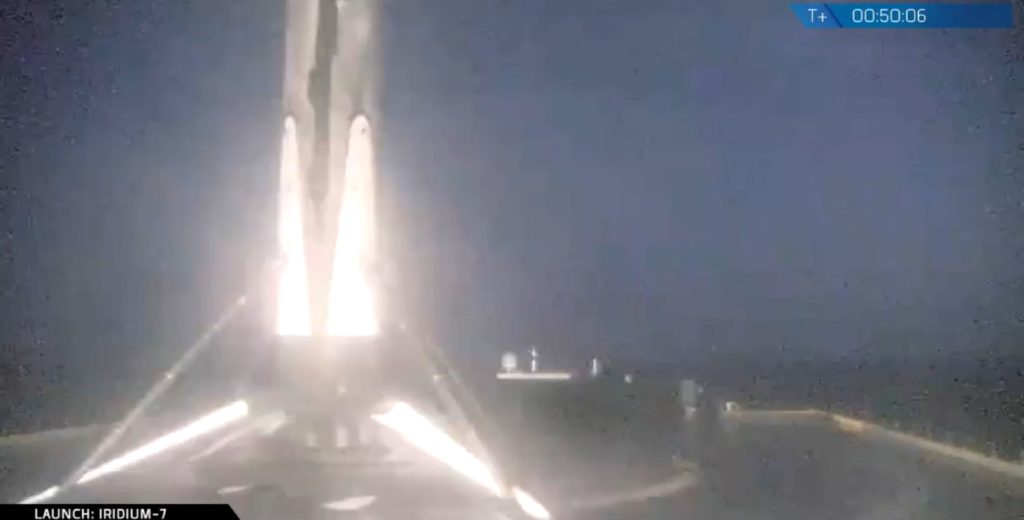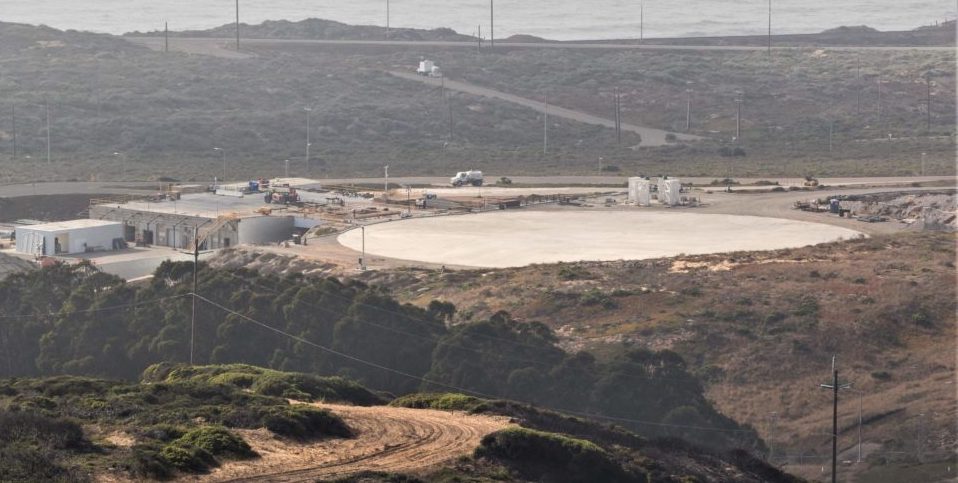
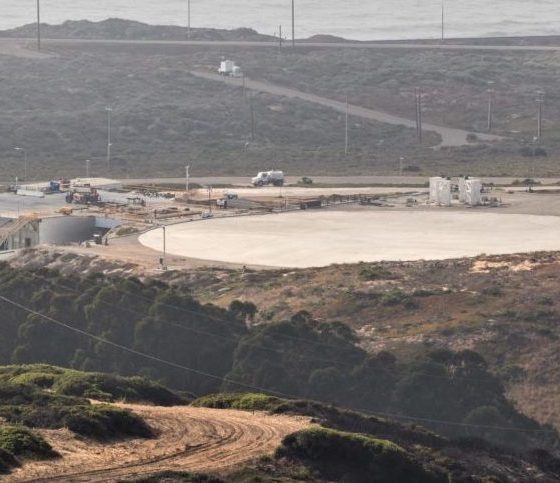
News
SpaceX readies its California landing pad for September rocket recovery debut
Just as SpaceX successfully debuted Falcon 9 Block 5 at their California launch pad and returned drone ship Just Read The Instructions (JRTI) to rocket recovery duty after a nine-month leave, the company’s next West Coast mission is already aligning for an early-September launch. The mission, SAOCOM-1A, will feature yet another inaugural event – the first use of a West Coast landing pad less than a mile from SpaceX’s Vandenberg launch pad.
For the last two and a half years, SpaceX’s Florida launch sites (Pad 40 and Pad 39A) have also been privy to a unique secondary facility known as Landing Zone-1, located a few miles away from both pads inside the boundaries of Cape Canaveral Air Force Station (CCAFS). In fact, although a number of attempts were made to recover a Falcon 9 booster aboard drone ship Of Course I Still Love You (OCISLY) in 2015, the first successful Falcon 9 booster landing happened to occur at LZ-1, followed four months later by the first successful recovery by sea.
SLC-4E after a foggy launch of Iridium-7 at Vandenberg. #spacex #iridium7 pic.twitter.com/YQkXbpBooj
— Pauline Acalin (@w00ki33) July 25, 2018
Why land on land, why land at sea?
The primary draw of an equivalent land-based pad is both simple and massive: while SpaceX’s autonomous drone ship vessels are complex, comparatively easy to damage, and extremely expensive to both operate and maintain, a concrete circle on land has relatively tiny fixed and variable costs, does not have to concern itself with volatile ocean conditions, and does not require a fleet of tugboats and service vessels to operate. Rough estimates place the cost of taking a drone ship, tugboat, and crew transport vessel hundreds of miles off the coast on missions that can last 7-14 days anywhere from $500,000 to $2 million or more, depending on how you tabulate costs. Either way, the drone ship fleet will always be more complex and more expensive than simple concrete pads on land.
One problem with land-based landing zones is that returning rockets to their launch sites is very fuel-intensive, requiring propellant margins at booster stage separation that dramatically reduce the payload that can be placed into low Earth orbit (LEO), let alone higher-energy missions to geostationary orbit. As such, without massive performance improvements, drone ships like JRTI and OCISLY will be irreplaceable for as long as Falcon 9 and Heavy are flying – SpaceX simply cannot recover rockets during the geostationary launches that comprise a huge portion of their manifest unless they have those vessels.
- Elon Musk walks among his recovered Falcon Heavy boosters at LZ-1 and 2. (Elon Musk)
- The drone ship Of Course I Still Love You spotted in Port Canaveral, FL last December. (Instagram /u/ johnabc123)
- West Coast drone ship Just Read The Instructions headed out to sea to catch a Block 5 booster on July 22. It succeeded. (Pauline Acalin)
This brings us to another conundrum. SpaceX’s Florida launch facilities support heavy commercial geostationary satellite launches as much as or more than any other type of payload in a given year of launches, meaning that the company’s now-doubled landing pad at LZ-1 is only used every once and awhile for Cargo Dragon launches and other miscellaneous and rare launches that leave enough margin in Falcon 9. SpaceX’s Vandenberg pad, on the other hand, is effectively bound to launching satellites into polar orbits (orbiting over Earth’s poles versus around the equator) – safety regulations prevent large rockets from launching over populated areas like the entire continental U.S., as an example for California launches.
Equatorial launches from East to West are much less efficient than their opposite, as Earth’s own rotation (West to East) provides rockets an appreciable performance boost. The point is that SpaceX’s Vandenberg launches are for fairly particular payloads, usually LEO communications satellites and imaging satellites that thrive in polar orbits, where one or a handful of satellites can observe almost anywhere on Earth over the course of a normal 24-hour. Those satellites also happen to be lightweight more often than not, meaning that many of the booster recoveries on drone ship JRTI could instead return to launch site (RTLS) for a dramatically simpler and cheaper recovery.
Enter Block 5
A West Coast LZ is even more intriguing and important with respect to the recent debut of Falcon 9 Block 5 at Vandenberg and the fact that all future launches. Even compared to SpaceX’s Florida LZ-1, the company’s Western pad is incredibly close to the launch pad. By landing less than a mile from SpaceX’s VAFB integration and refurbishment facilities (and launch pad), recovery and refurbishment operations should be more effortless than any before it.
- SpaceX’s yet-unused Californian Landing Zone, seen ahead of Falcon 9 Block 5’s Iridium-7 debut. (Pauline Acalin)
- SpaceX’s Vandenberg launch pad (right) and landing zone (left) ahead of the pad’s first Falcon 9 Block 5 launch, Iridium-7. (Pauline Acalin)
While the company’s VAFB launch pad is a bit older than its Eastern cousins and requires at least 3-5 weeks between launches for repairs and refurbishment, that relaxed schedule may be unbeatable for proving out the Block 5 upgrade’s true rapid reusability, as well as its ability to far more than two orbital missions per booster lifespan. SAOCOM-1A, one of two Argentinian Earth observations scheduled for launch with SpaceX, will begin that new era for SpaceX’s Vandenberg operations, including a landing pad debut permit officially granted by the FCC in the last few weeks. The Falcon 9 booster that launches that mission is bound to have a storied future ahead of itself.
For prompt updates, on-the-ground perspectives, and unique glimpses of SpaceX’s rocket recovery fleet (including fairing catcher Mr Steven) check out our brand new LaunchPad and LandingZone newsletters!

News
I subscribed to Tesla Full Self-Driving after four free months: here’s why
It has been incredibly valuable to me, and that is what my main factor was in considering whether to subscribe or not. It has made driving much less stressful and much more enjoyable.

I have been lucky enough to experience Tesla Full Self-Driving for the entire duration of my ownership experience for free — for four months, I have not had to pay for what I feel is the best semi-autonomous driving suite on the market.
Today, my free trial finally ran out, and I had two choices: I could go without it for a period until I felt like I absolutely needed it, or I could subscribe to it, pay $99 per month, and continue to experience the future of passenger transportation.
I chose the latter, here’s why.
Tesla Full Self-Driving Takes the Stress Out of Driving
There are a handful of driving situations that I don’t really enjoy, and I think we all have certain situations that we would just rather not encounter. This is not to say that I won’t ever experience them as someone who has driven a car for 15 years (it feels weird saying that).
I don’t love to drive in cities; I really don’t like driving on I-695 on my way to Baltimore, and I truly hate parallel parking. All three things I can do and have done, all three within the past few weeks, too.
It takes all the stress out of city driving pic.twitter.com/q0SPPrH4HU
— TESLARATI (@Teslarati) December 4, 2025
However, if I can avoid them, I will, and Tesla Full Self-Driving does that for me.
Tesla Full Self-Driving Eliminates the Monotony
I drive to my alma mater, Penn State University, frequently in the Winter as I am a season ticket holder to Wrestling and have been for 16 years now.
The drive to State College is over two hours and over 100 miles in total, and the vast majority of it is boring as I travel on Rt 322, which is straight, and there is a lot of nature to look at on the way.
I am willing to let the car drive me on that ride, especially considering it is usually very low traffic, and the vast majority of it is spent on the highway.
The drive, along with several others, is simply a boring ride, where I’d much rather be looking out the windshield and windows at the mountains. I still pay attention, but having the car perform the turns and speed control makes the drive more enjoyable.
Tesla Full Self-Driving Makes Navigating Easier
Other than the local routes that I routinely travel and know like the back of my hand, I’ve really enjoyed Full Self-Driving’s ability to get me to places — specifically new ones — without me having to constantly check back at the Navigation.
Admittedly, I’ve had some qualms with the Nav, especially with some routing and the lack of ability to choose a specific route after starting a drive. For example, it takes a very interesting route to my local Supercharger, one that nobody local to my area would consider.
But there are many times I will go to a new palce and I’m not exactly sure where to go or how to get there. The Navigation, of course, helps with that. However, it is really a luxury to have my car do it for me.
To Conclude
There was no doubt in my mind that when my Full Self-Driving trial was up, I’d be subscribing. It was really a no-brainer. I am more than aware that Full Self-Driving is far from perfect, but it is, without any doubt, the best thing about my Tesla, to me.
It has been incredibly valuable to me, and that is what my main factor was in considering whether to subscribe or not. It has made driving much less stressful and much more enjoyable.
🚨 How I’ve gotten Tesla Full Self-Driving for free…until now
Watch me subscribe to Tesla FSD! https://t.co/bjK7EEOptR pic.twitter.com/cs5CmN5PdJ
— TESLARATI (@Teslarati) January 7, 2026
News
Tesla Diner becomes latest target of gloom and doom narrative

The Tesla Diner has been subject to many points of criticism since its launch in mid-2025, and skeptics and disbelievers claim the company’s latest novel concept is on its way down, but there’s a lot of evidence to state that is not the case.
The piece cites anecdotal evidence like empty parking lots, more staff than customers during a December visit, removed novelty items, like Optimus robot popcorn service and certain menu items, the departure of celebrity chef Eric Greenspan in November 2025, slow service, high prices, and a shift in recent Google/Yelp reviews toward disappointment.
The piece frames this as part of broader Tesla struggles, including sales figures and Elon Musk’s polarizing image, calling it a failed branding exercise rather than a sustainable restaurant.
This narrative is overstated and sensationalized, and is a good representation of coverage on Tesla by today’s media.
Novelty Fade is Normal, Not Failure
Any hyped launch, especially a unique Tesla-branded destination blending dining, Supercharging, and a drive-in theater, naturally sees initial crowds taper off after the “Instagram effect” wears down.
Tesla makes major change at Supercharger Diner amid epic demand
This is common for experiential spots in Los Angeles, especially pop-up attractions or celebrity-backed venues. The article admits early success with massive lines and social media buzz, but treats the return to normal operations as “dying down.”
In reality, this stabilization is a healthy sign of transitioning from hype-driven traffic to steady patronage.
Actual Performance Metrics Contradict “Ghost Town” Claims
- In Q4 2025, the Diner generated over $1 million in revenue, exceeding the average McDonald’s location
- It sold over 30,000 burgers and 83,000 fries in that quarter alone. These figures indicate a strong ongoing business, especially for a single-location prototype focused on enhancing Supercharger experiences rather than competing as a mass-market chain
It’s not a ghost town lol. The @Tesla Diner still had over 30,000 burger orders and 83,000 fries orders in Q4. The diner generated over $1M in revenue in Q4, a $4M annual run rate, which is more than the average McDonald’s…. pic.twitter.com/XvAGLUqxej
— Sawyer Merritt (@SawyerMerritt) January 4, 2026
Conflicting On-the-Ground Reports
While the article, and other similar pieces, describe a half-full parking lot and sparse customers during specific off-peak visits, other recent accounts push back:
- A January 2026 X post noted 50 of 80 Supercharger stalls were busy at 11 a.m., calling it “the busiest diner in Hollywood by close to an order of magnitude
TESLA DINER 🍔
Frantic!!!
Crazy busy. pic.twitter.com/wMbmr8SFFn
— Rich & Sharon (@HullTeslaModel3) January 4, 2026
- Reddit discussions around the same time describe it as not empty when locals drive by regularly, with some calling the empty narrative “disingenuous anti-Tesla slop.”
When we visited it last week it was packed. We had to wait to enter, get a table and go to the restroom. We were lucky to find a spot to charge.
— Rani G (@ranig) January 4, 2026
Bottom Line
The Tesla Diner, admittedly, is not the nonstop circus it was at launch–that was never sustainable or intended. But, it’s far from “dying” or an “empty pit stop.”
It functions as a successful prototype: boosting Supercharger usage, generating solid revenue, and serving as a branded amenity in the high-traffic EV market of Los Angeles.
News
Tesla stands to win big from potential adjustment to autonomous vehicle limitations
Enabling scale, innovation, and profitability in a sector that is growing quickly would benefit Tesla significantly, especially as it has established itself as a leader.

Tesla stands to be a big winner from a potential easing of limitations on autonomous vehicle development, as the United States government could back off from the restrictions placed on companies developing self-driving car programs.
The U.S. House Energy and Commerce subcommittee will hold a hearing later this month that will aim to accelerate the deployment of autonomous vehicles. There are several key proposals that could impact the development of self-driving cars and potentially accelerate the deployment of this technology across the country.
These key proposals include raising the NHTSA’s exemption cap from 2,500 to 90,000 vehicles per year per automaker, preempting state-level regulations on autonomous vehicle systems, and mandating NHTSA guidelines for calibrating advanced driver assistance systems (ADAS).
Congress, to this point, has been divided on AV rules, with past bills like the 2017 House-passed measure stalling in the Senate. Recent pushes come from automakers urging the Trump administration to act faster amid competition from Chinese companies.
Companies like Tesla, who launched a Robotaxi service in Austin and the Bay Area last year, and Alphabet’s Waymo are highlighted as potential beneficiaries from lighter sanctions on AV development.
The NHTSA recently pledged to adopt a quicker exemption review for autonomous vehicle companies, and supporters of self-driving tech argue this will boost U.S. innovation, while critics are concerned about safety and job risks.
How Tesla Could Benefit from the Proposed Legislation
Tesla, under CEO Elon Musk’s leadership, has positioned itself as a pioneer in autonomous driving technology with its Full Self-Driving software and ambitious Robotaxi plans, including the Cybercab, which was unveiled in late 2024.
The draft legislation under consideration by the U.S. House subcommittee could provide Tesla with significant advantages, potentially transforming its operational and financial landscape.
NHTSA Exemption Cap Increase
First, the proposed increase in the NHTSA exemption cap from 2,500 to 90,000 vehicles annually would allow Tesla to scale up development dramatically.
Currently, regulatory hurdles limit how many fully autonomous vehicles can hit the roads without exhaustive approvals. For Tesla, this means accelerating the rollout of its robotaxi fleet, which Musk envisions as a network of millions of vehicles generating recurring revenue through ride-hailing. With Tesla’s vast existing fleet of over 6 million vehicles equipped with FSD hardware, a higher cap could enable rapid conversion and deployment, turning parked cars into profit centers overnight.
Preempting State Regulations
A united Federal framework would be created if it could preempt State regulations, eliminating the patchwork of rules that currently complicate interstate operations. Tesla has faced scrutiny and restrictions in states like California, especially as it has faced harsh criticism through imposed testing limits.
A federal override of State-level rules would reduce legal battles, compliance costs, and delays, allowing Tesla to expand services nationwide more seamlessly.
This is crucial for Tesla’s growth strategy, as it operates in multiple markets and aims for a coast-to-coast Robotaxi network, competing directly with Waymo’s city-specific expansions.
Bringing Safety Standards to the Present Day
Innovation in the passenger transportation sector has continued to outpace both State and Federal-level legislation, which has caused a lag in the development of many things, most notably, self-driving technology.
Updating these outdated safety standards, especially waiving requirements for steering wheels or mirrors, directly benefits Tesla’s innovative designs. Tesla wanted to ship Cybertruck without side mirrors, but Federal regulations required the company to equip the pickup with them.
Cybercab is also planned to be released without a steering wheel or pedals, and is tailored for full autonomy, but current rules would mandate human-ready features.
Streamlined NHTSA reviews would further expedite approvals, addressing Tesla’s complaints about bureaucratic slowdowns. In a letter written in June to the Trump Administration, automakers, including Tesla, urged faster action, and this legislation could deliver it.
In Summary
This legislation represents a potential regulatory tailwind for Tesla, but it still relies on the government to put forth action to make things easier from a regulatory perspective. Enabling scale, innovation, and profitability in a sector that is growing quickly would benefit Tesla significantly, especially as it has established itself as a leader.
